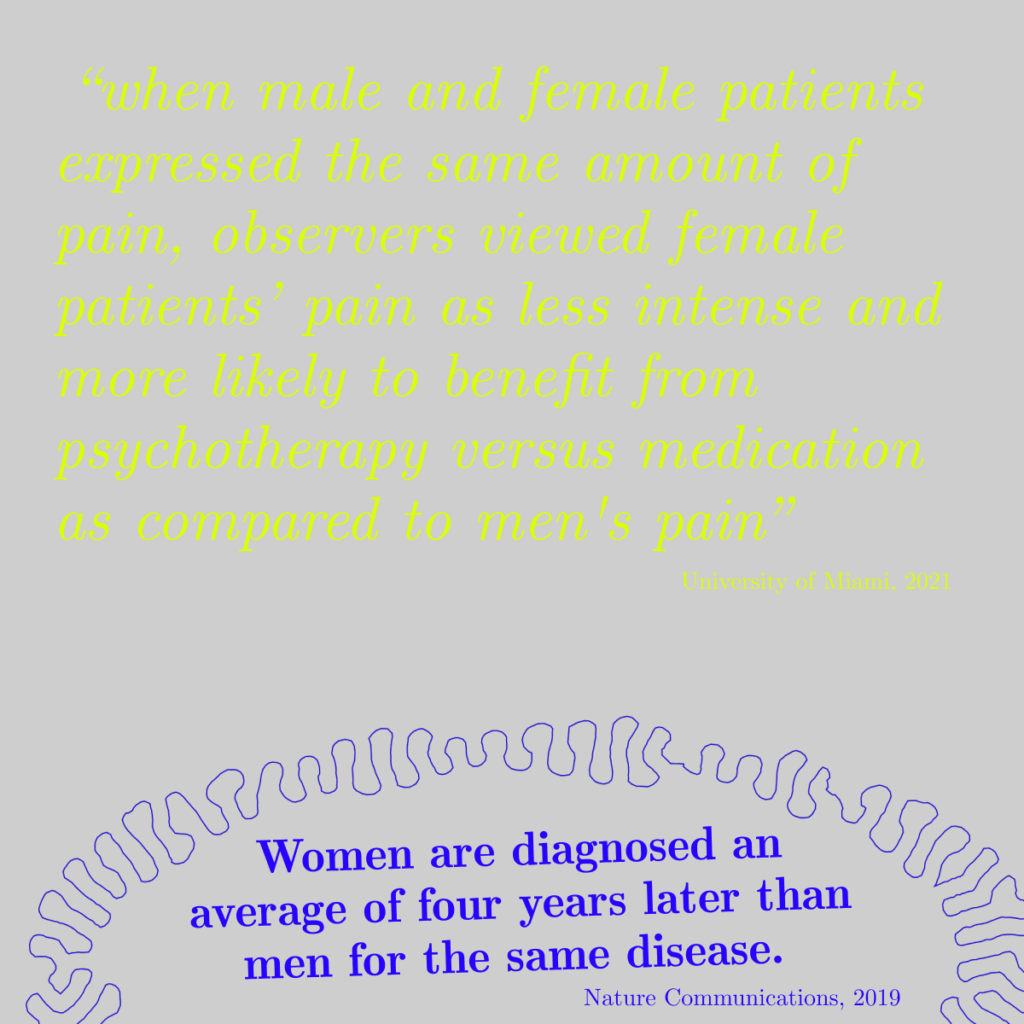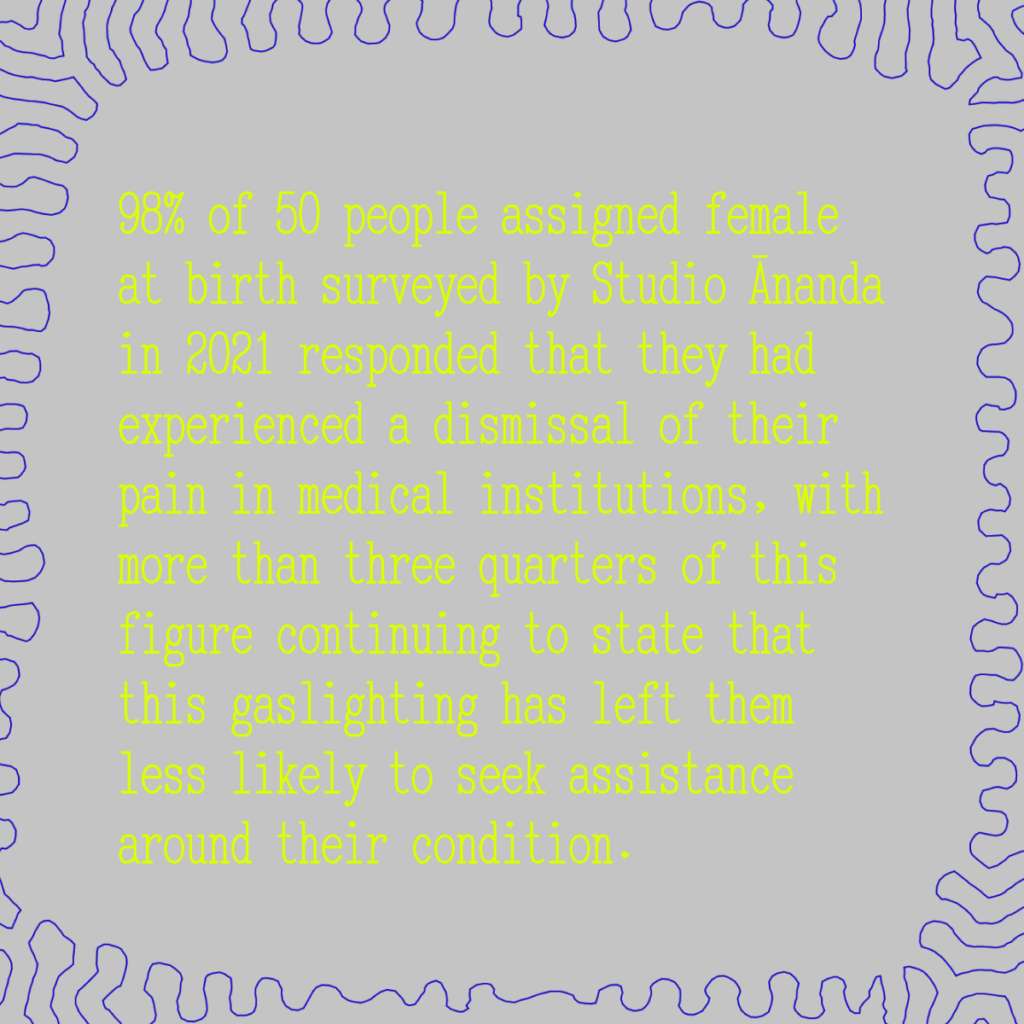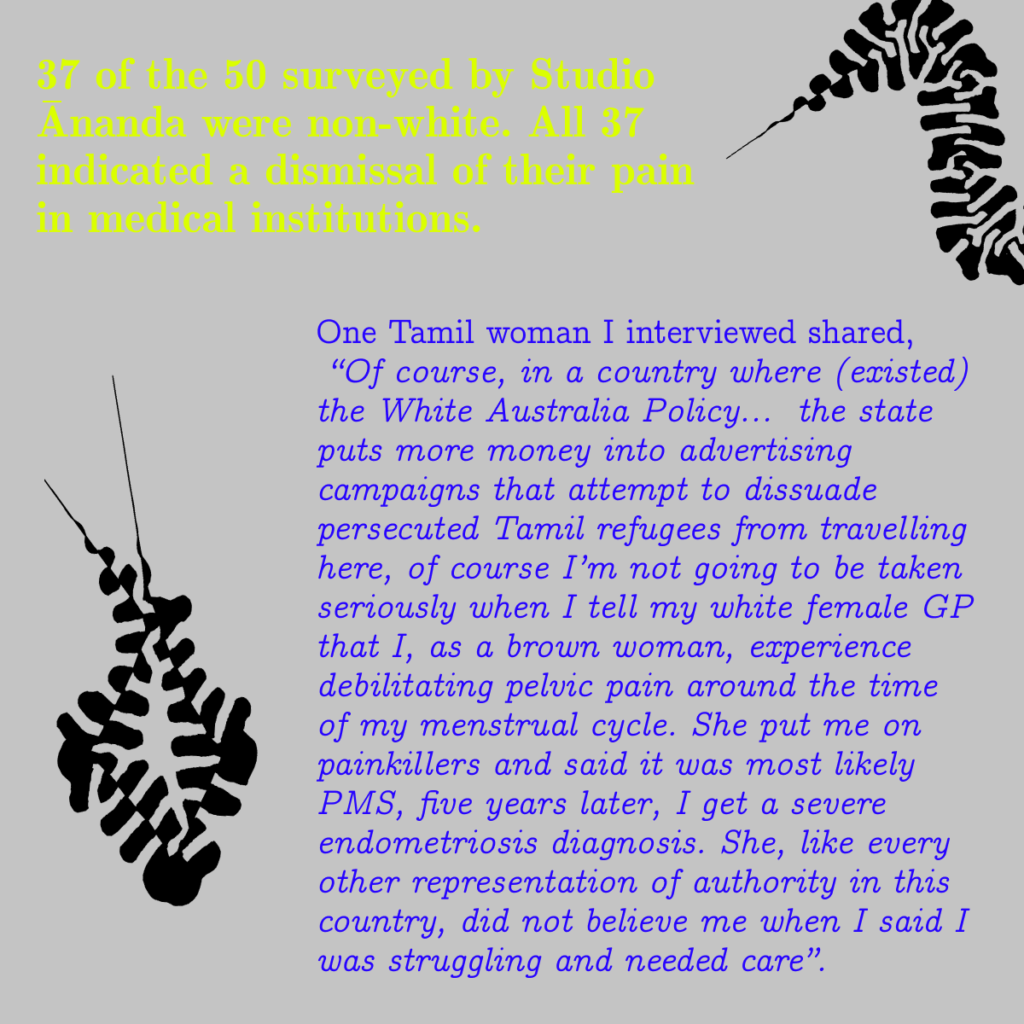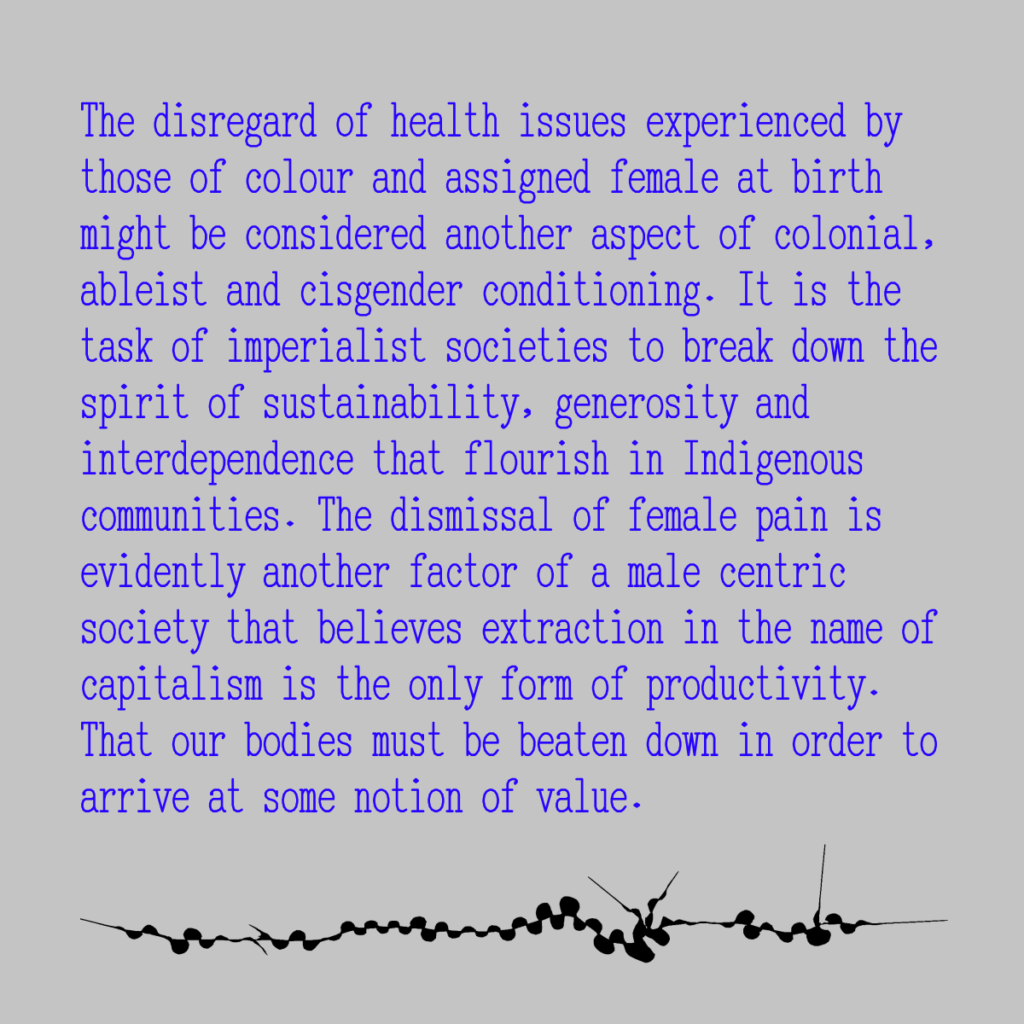Up until April 2020, I would often forget that I had a body. Moving through systems of capitalist imperialism and heteronormative white supremacy in a queer, brown, unknowingly chronically ill body would often render me detached. I was dissociated, to say the least. Feeding my body foods that inflamed it, exposing it to degrading sexual situations, occupying relationships that were energetically draining;tuck in fight or flight. Despite being raised in one of the most qualitatively healthy societies—in Sydney, Australia—no one believed my pain. I, myself, did not have the tools to understand my own experience. Maintaining a strong mind and an uplifted spirit was my only priority because having them that allowed me to survive years of incest. My body has always been an afterthought.
This research came to me in April 2021 after a particularly painful wisdom tooth removal. During the extraction, as the dentist prodded at a nerve in my jaw, I requested more anaesthesia. My request was denied with, ‘it’s probably just muscle pain.’ The pain during and after this experience spun me into a web of wanting to understand how and why medical practitioners in western systems are so quick to dismiss the pain of, in particular, those of us of colour and assigned female at birth. I began obsessively talking to the women around me about their experience, most of them queer and non white. A pattern quickly emerged. As I began the primary research for this series, interviewing and surveying those in the community, I was reminded of the systemic dismissal of pain associated within communities of colour, regarding the female reproductive system. This led me down a rabbit hole by which I discovered I myself have been living with acute endometriosis, a condition I once considered vaginismus. It’s difficult to articulate how my own perception of self pain was numbed by my dissociative and distracted nature. My own ableist perspective dismissed the chronic pain I have been experiencing for the past ten years to the point where my own body was fighting me.
Moving towards a fully integrated lifestyle, as I began to enact boundaries with myself and others, as I listened closely to my intuition and have been rewiring my brain, I’ve become more and more aware of the pain in my body. After ten years of desensitization, something switched within me and I began to integrate my chronic condition, what I now know to be my body’s response to childhood sexual abuse and inherited ancestral trauma. It took me over a year to arrive at my diagnosis, one that was riddled with grief, sorrow and moments of joy and triumph. I honour and uplift the practitioners of alternative medicine, my acupuncturist, ayurvedic doctor and EMDR therapist, my healed and benevolent feminine ancestors and sisters in solidarity, who have guided me through this journey.
**
Where the modern institution of medicine in the global north has been built and based off scientific data compiled mostly by cisgender white men throughout history, it is not surprising, although consistently alarming, that many queer and people assigned female at birth who move through these systems experience dismissal or gaslighting of their pain. From reproductive pain to the regular migraine, women in particular experience a greater dismissal of pain than men in the medical institution. A recent study by the University of Miami highlights how “when male and female patients expressed the same amount of pain, observers viewed female patients’ pain as less intense and more likely to benefit from psychotherapy versus medication as compared to men’s pain”. Not only does this clarify a significant patient gender bias that can lead to disparities in treatment, it also says a lot about the psychosocial conditioning that exists in mainstream societies perception around femme pain. Female pain is considered less a biological and more a psychological issue. To understand the extent of this conditioning, one can turn to a 2019 Danish study of health data collected over two decades from 6.9 million people, that revealed that women are diagnosed an average of four years later than men for the same disease.

The experience of pain dismissal is a biopsychosocial one and even if not immediately traumatizing, has long lasting effects on the way a femme person interacts safely and securely with systems of health and their own bodies. As Western medical thought has been heavily influenced by European and colonial discoveries, there is no denying that presenting as a non white femme in medical institutions brings with it added complexities when having your pain taken seriously. It becomes even more complex when you exist as a queer, non white person.
Over the past decade, studies have shown that from the prescriptions of less effective pain medication to longer wait times in emergency rooms, women and femme presenting people are more likely to be taken less seriously than men. Regardless of the gender of the general practitioner, there is countless evidence to prove that women are consistently misdiagnosed, underdiagnosed and not diagnosed. To understand this bias, it is first necessary to to take a look at the history of modern medicine. To understand the bias’ breadth, it is imperative to understand how communities of colour suffer the most from this prejudiced perception.
1. The History of Modern Medicine
The history of modern medicine, like every other prevalent institution, is tainted by its own political, social and cultural agenda. The socially constructed gender binary has been integrated and enforced by the institute of medicine across time, ascribing power and dominance to men. Within the context of heteronormative imperialist states, male dominance, and a priortisation and superirority of the male body is imprinted in western medicines foundation.. As early as Greece in the third century BCE when Aristotle described the female body as the inverse of the male, with our genitalia “turn’d outside in”, women were marked and medically defined as deficient, defective and faulty. Awareness around female biology revolved around our capacity to reproduce. The uterus was misunderstood and while not all women have uteruses, and not all of us who menstruate are women, historically, the institute of medicine has conflated biological sex with gender identity. Before medicine became an evidence based science, medical myths were based on social constructs and biases. Today, these myths can be the difference between life or death for femmes and queer people.
In May 2021, I surveyed fifty women and people assigned female at birth. The group aged between 15 – 65 and were a mix of African, East Asian, South Asian and Caucasian descent, located across Australia, the United States, the United Kingdom and France. 44% of those surveyed identified as queer and 56% as straight. 98% of those that I surveyed responded that they had experienced a dismissal of their pain in medical institutions, with more than three quarters of this figure continuing to state that this gaslighting has left them less likely to seek assistance around their condition. A report by the US Public Health Task Force on Women’s Health warned in 1985 that, “the historical lack of research focus on women’s health concerns has compromised the quality of health information available to women as well as the health care they receive”. This riveting fact should cause a great amount of caution when considering the lives of femmes in medical institutions and yet, it feels as if women are expected to manage health related issues themselves instead of demanding systemic change. Further, lack of funding towards female specific health related issues remains a major issue across the world.

The perpetuation of women as naturally inferior in medicine is explicit. In a world where menstruation and menopause are both considered valid reasons for women not to hold positions of power, one must challenge how these narratives are solidified through systems of authority. Clinical research, both within and outside of the medical institution, has an entrenched bias against women. 8 out of the 10 prescription drugs taken off the market by the US Food and Drug Administration between 1997 and 2000 had severe adverse effects that caused greater health risks in women. Across the global north, the violation of women’s reproductive autonomy is ongoing with the criminalisation of abortion being a mainstream perspective. Where the spirit of the feminine exudes abundance, generosity and sensitivity, the western medical institution sits in direct contradiction with the way it fails to respect, hear and care for those assigned female at birth holistically.
As expected, this bias extends beyond the human being. Historically, not only have researchers, doctors, scientists and their subjects predominantly been male, most cells and animals studied in medical research have also been male. A 2010 study on sex bias in research on mammals in 10 biological fields found that “male bias was evident in eight disciplines and most prominent in neuroscience, with single-sex studies of male animals outnumbering those of females 5 to 1…. Under-representation of females in animal models of disease is also commonplace, and our understanding of female biology is compromised by these deficiencies”. Today, we know less about every aspect of female biology compared to male biology.
**
In The Right to Sex, Amia Srinivasan writes “there is no civilisation under the patriarchy”. In the modern world where male dominance is a pillar of what is considered to be civil, there is no true equity and equality for women beyond the faux trappings of neoliberal concepts of justice. Women might be making more money today than generations before, but what does it matter if we are still treated as subordinate by systems that supposedly deliver us care?
Considering that many of these institutions of health have been imposed and developed through regimes of imperialism, the gender binary is simply another colonial project that frames ongoing relationships and seeks to restrict the existence of women and those assigned female. Now consider the intersection of race, and the added layer of difficulty for femmes of colour moving through medical spaces that have been built on scientifics myths of racial inferiority.
2. The Effects of Medical Gender Bias on Communities of Colour
Out of the fifty people assigned female at birth that I surveyed, 37 identified as non white. All of these women also went on to indicate a dismissal of their pain. In follow up interviews with some of these women, all of the Black women I spoke to explicitly stated their understanding that as dark skin femmes, they are expected to have a higher tolerance of pain. One Tamil woman I spoke with, located in Australia, eluded to histories of xenophobic treatment of refugees on the island as a key factor as to why her chronic pain was diagnosed incorrectly for years. She shared,
“Of course, in a country where (existed) the White Australia Policy… the state puts more money into advertising campaigns that attempt to dissuade persecuted refugees from travelling here…I’m not going to be taken seriously when I tell my white, female GP that I, a brown woman, experience debilitating pelvic pain around the time of my menstrual cycle. She put me on painkillers and said it was most likely PMS, five years later, I get a severe endometriosis diagnosis. She, like every other representation of authority in this country, did not believe me when I said I was struggling and needed care.”

Around the time that I began this research, I insisted on speaking to any woman that I crossed paths with about their experiences with pain. One conversation that struck me in particular was with a close friend of South Asian descent. She voiced her disdain for her (also South Asian GP) for not offering anaesthesia when inserting her IUD. The conversation reminded me of my own experience with my family GP, a Tamil woman, who when confirming my vaginismus at age 18, poked and prodded at my vagina and concluded,
“You won’t be needing it until you’re married anyway, so you’ll be fine.”
When attempting to understand how female medical practitioners have categorically undermined the experience of their femme patients who are of the same ethnic background, I can only conclude that the penetration of colonial and ableist perspectives have been so completely internalized leaving no real room for empathy and connection, even between women of similar lived experiences. I speak from my perspective as a queer Tamil woman who has avoided South Asian practitioners in western institutions for this very reason. The day after I received my endometriosis diagnosis, my maternal grandmother passed away. She was not only disabled, but had been dealing with various health conditions since migrating to Australia from Jaffna in the early 2000s. Her cause of death was a combination of things.,however, when reflecting on the days before her passing and her reluctance to seek medical help despite experiencing a high fever, the stark intergenerational component to the dismissal of femme women of colour’s pain is illustrated. One might argue that this phenomenon is ancestral. The colonial dismissal of Indigenous knowledge is part and parcel of the way non white femmes are treated in western medical institutions.
From the late eighteenth century onwards, medicine was an important part of the colonising process, constituting a large part of political and cultural interaction between imperialist Europe and America and the Indigenous peoples of Africa, Asia, Latin America and Oceania. Research in the areas of gender and medicine highlights how gender and health care were linked in colonial ideology, propagating the paternalistic and benevolent aspects of a ‘civilized’ imperial rule. Taking colonial India as a case study presents a striking illustration of imperial imposition, internalization and integration of colonial mindsets across the hegemony.
British intervention in Indian women’s health began in the 1860s with the Contagious Diseases Act, designed to protect the health of British soldiers by quarantining Indian prostitutes in lock hospitals to prevent the spread of venereal diseases. From the beginning of medical imperialism in India, the agenda was to protect the British rather than the Indigenous. Next, the women’s quarters in upper caste Hindu and Muslim households known as the zenana became of critical attention, with white women missionairies waging a battle against ignorance of health and hygiene in these spaces. All in the name of Christianity and conversion.
Foucault’s notion of the ‘clinical gaze’ can be seen here with the modification of a patient’s experience based on the biomedical paradigm held by the medical practitioner. White female missionaries set out on a mission to colonize Indian women by opening up the zenana and therefore allowing the imperial gaze to seep deeper into the fabric of Indian society. Despite an ideology of feminism that was certainly present in this endeavour, it was underscored by the imperialist mode of white feminism developing in the early nineteenth century. White women were on top of an imaginary, hegemonic order and the health of Indian women was a gauge of their own process.
Given the history of medical imperialism in South Asia and the global south at large, one might understand the internalization of the dominant ideology that exists amongst practitioners of colour in the western medical institution. The above is just one history. There exists a plethora more. My grandmother was born a Hindu and went on to be orphaned by Christian nurses in Sri Lanka when she became ill as a child. I wonder how her relationship with her body would have differed if she was given access to her own Indigenous medicine as a young girl. The legacies of intergenerational trauma are imbued in communities of colour. Knowing this allows me to make some sort of peace with my own chronic pain, endometriosis as a genetic and ancestral condition.
The disregard of health issues experienced by those of colour and assigned female at birth might therefore be considered another aspect of colonial, ableist and cisgender conditioning. It is the task of imperialist societies to break down the spirit of sustainability, generosity and interdependence that flourish in Indigenous communities. The dismissal of female pain is evidently another factor of a male centric society that believes extraction in the name of capitalism is the only form of productivity. That our bodies must be beaten down in order to arrive at some notion of value.

What then are we to make of the First Nations peoples of the global north who continue to live at odds with mainstream society? The undermining of Indigenous communities in the ‘developing’ world is assumed to be a static event that happened during colonialism. Of course, this framework does not take into account the intergenerational effects of imperialism and systems of neocolonialism that have emerged in a postcolonial world. In the so called ‘developed’ world, though, imposition is more discrete. It is accepted with land acknowledgements and cultural renamings of sacred sites a performative action by neoliberal states to mitigate the ongoing acts of violence endured through neocolonialism.
Systemic racism within western healthcare systems that disproportionately affect First Nations people is a crisis that persists across the modern world. Reports by the Australian Institute of Health and Welfare shows that Indigenous Australians are more likely to have lengthy and complex general practitioner consultations than non Indigenous Australians. Between 2018 – 2019, Indigenous Australians waited longer to be admitted to elective surgery than non Indigenous Australians. The potentially avoidable mortality rate of Indigenous Australians was 3 times the rate than non Indigenous Australians in 2018, and between 2018 – 2019, the rate of potentially avoidable hospitalisations was 2.8 times higher than non Indigenous Australians. Similarly, in Canada, Indigenous peoples continue to experience barriers to health care, resulting in significant and ongoing health disparities, compared to other Canadians. Australia and Canada are nations with universal healthcare systems that are considered to be among the best in the world, and yet, targeted discrimination and intergenerational trauma continues to undermine the health and wellbeing of their First Nations people.
Across the ‘developed’ world, Indigenous women are more vulnerable to violence and mistreatment which is fueled by biases held in healthcare systems. In Canada, pregnant Indigenous women are more likely to be denied pain medication by staff than their non Indigenous counterparts. The life expectancy of Métis and First Nations women is projected to be five years less than non Indigenous Canadian women, while Inuit women is a disturbing ten years. Paralleled is the situation in Australia where the same policies of the 1860s colonial lock hospitals enacted in India under the Contagious Diseases Act, clinically gazed and infringed upon Aboriginal women. There are countless reports on how Aboriginal women in Australia are refused medical help for their pain by practitioners who believe they are under the influence of drugs and alcohol.
Narratives of inferiority and stigmas around the lifestyles and histories of Indigenous communities are woven into modern systems of ‘care’. The continuous lack of recognition and respect of Indigenous people’s ability to fulfill their own economic, political, cultural and social rights undoubtedly drives health disparities and the inequitable distribution of resources for care.
The linear narrativization of entire communities is dangerous in all forms. Some of the most violent experiences of pain dismissal I have gathered through my research, however, come from dark skin, predominantly Black femmes. The neoliberal slogan that race is only skin deep is horrendously inappropriate when considering that the colour of a woman’s skin is often a gauge for the amount of pain they may be able to tolerate.
In the follow up interviews I conducted with my surveyees, when asked why they think medical practitioners are more likely to ignore the pain of a non white woman, one Black woman responded,
“There is this idea that comes with epigenetics and Darwinism and evolution theories that, because I’m dark skinned, I have thicker skin, I have an ability to withstand harsh conditions. When I persist that I am in pain and need serious attention, I become the angry Black woman. It’s completely dehumanizing and is my everyday reality as someone who has chronic back pain and has to face the American healthcare system.”
Where the State of America is it’s own monster in the way it’s institutions have been built upon the backs of slave labour and are maintained with an ethos that continues to degrade and diminish Black communities, there are so many different points of entry in understanding the dismissal of femme Black pain.
In 1965, the Moynihan Report became an established ideological apparatus in America. Wholly racist and completely disingenuous, the report inscribed ethnicity, particularly, Blackess, as a scene of negation to whiteness and inferred that the human body was a metonymic figure for the entire repertoire of human and social arrangements. Under this logic, the slave system could not recognise a matriarchal family structure due to the Black slave woman’s risk to authority. This risk was their ability to minister to the needs of the men, children and community around them in a way that could not directly and immediately be claimed by the oppressor. Critiquing Moynihan in Mama’s Baby Papa’s Baby, Hortense Spillers considers the report to be the first site of Black gendered degradation and inspirationally asks how one can gender in a way that grounds other forms of social life. In her text, Spillers recognizes the gendering of Black women through imperialist frameworks has reduced them to flesh: shredded, exploited and abused. The loss of Indigenous land, for Spillers, provides a metaphor of displacement for other gendered human and cultural features and relations for Black women, including the displacement of their bodies.
Throughout this text I have laid out how histories of subjugation are entrenched in our modern medical systems of care. Racial bias in America, a country that was founded on the encapsulation and violation of Black women, exemplifies this. In a 2016 study on racial bias in pain treatment, researchers found 50% of medical students and residents believed Black people have less sensitive nerve endings, thicker skin, or stronger immune systems that would require less invasive pain care than white patients. An analysis of 20 years of research in America in 2012 found that Black women were 22 percent less likely to receive pain medication from their practitioners than non Black Americans. Follow up research suggests this is because health care providers believe falsely that Black patients are more likely to abuse pain killer medication. There is certainly an inextricable link between the believed disposability of Black women and an underestimation of their pain.
Anne Boyer writes in The Undying, “Disease is never neutral. Treatment is never not ideological. Mortality never without politics”. If the ways our bodies experience health and wellbeing is marked by our histories in this life, queer, non white people who are assigned female at birth and experience persistently dismissed pain are the epitome of the violence enacted through regimes of imperialism, white supremacy, male dominance and capitalism. Pain is subjective. It is often described as inarticulate, in that, there is no shared language on how it is universally experienced. Maybe if we listened more deeply and attentively to the non white femmes in our lives and developed a language around care based on empathy and compassion, maybe if we considered the knowledges and lifestyles of Indigenous people and communities prior to colonization, perhaps if we venerated women for their divine ability to nurture and provide, maybe then there might be a shift in the violence experienced by many of us in health care systems.
This is the first in a three part series on the Dismissal of Queer and Femme Pain by Prinita Thevarajah for Studio Ānanda.
